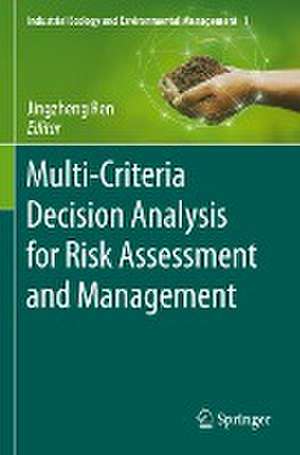Multi-Criteria Decision Analysis for Risk Assessment and Management: Industrial Ecology and Environmental Management, cartea 1
Editat de Jingzheng Renen Limba Engleză Paperback – 14 noi 2022
There is a total of ten chapters, mainly including the indicators and organizational models for risk assessment, the integrated Bayesian Best-Worst method and classifiable TOPSIS model for risk assessment, new risk prioritization model, fuzzy risk assessment under uncertainties, assessment of COVID-19 transmission risk based on fuzzy inference system, risk assessment and mitigation based on simulation output analysis, energy supply risk analysis, risk assessment and management in cash-in-transit vehicle routing problems, and sustainability risks of resource-exhausted cities.
The most significant feature of this book is that it provides various systematic multi-criteria decision analysis methods for risk assessment and management, and illustrates the application of these methods in different fields. This book is beneficial to policymakers, decision-makers, experts, researchers and students related to risk assessment and management.
| Toate formatele și edițiile | Preț | Express |
|---|---|---|
| Paperback (1) | 888.49 lei 6-8 săpt. | |
| Springer International Publishing – 14 noi 2022 | 888.49 lei 6-8 săpt. | |
| Hardback (1) | 894.46 lei 6-8 săpt. | |
| Springer International Publishing – 14 noi 2021 | 894.46 lei 6-8 săpt. |
Preț: 888.49 lei
Preț vechi: 1083.53 lei
-18% Nou
Puncte Express: 1333
Preț estimativ în valută:
170.02€ • 181.80$ • 141.75£
170.02€ • 181.80$ • 141.75£
Carte tipărită la comandă
Livrare economică 17 aprilie-01 mai
Preluare comenzi: 021 569.72.76
Specificații
ISBN-13: 9783030781545
ISBN-10: 3030781542
Pagini: 252
Ilustrații: VIII, 252 p. 53 illus., 36 illus. in color.
Dimensiuni: 155 x 235 mm
Greutate: 0.37 kg
Ediția:1st ed. 2021
Editura: Springer International Publishing
Colecția Springer
Seria Industrial Ecology and Environmental Management
Locul publicării:Cham, Switzerland
ISBN-10: 3030781542
Pagini: 252
Ilustrații: VIII, 252 p. 53 illus., 36 illus. in color.
Dimensiuni: 155 x 235 mm
Greutate: 0.37 kg
Ediția:1st ed. 2021
Editura: Springer International Publishing
Colecția Springer
Seria Industrial Ecology and Environmental Management
Locul publicării:Cham, Switzerland
Cuprins
Risk assessment: indicators and organizational models.- An integrated Bayesian BWM and classifiable TOPSIS model for risk assessment.- A modified risk prioritization approach using best-worst method.- Fuzzy Risk Assessment In the Presence of Uncertainties in Heterogeneous Preferences Elicitation and Reliability.- Assessment of COVID-19 transmission risk through fuzzy inference system; an application for mining activities.- Simulation Output Analysis for Risk Assessment and Mitigation.- Cause-Effect Analysis, Barriers Identification and Policy Implications for China’s Energy Security.- Quantitative Risk Assessment and Management of Cash-in-Transit Vehicle Routing Problems.- Mitigating Energy Supply Risks: Factors Identification and Pathway Selection for China’s Renewable Energy Development Fuzzy PROMETHEE.- Sustainability risks of resource-exhausted cities in China: A principal component analysis.
Notă biografică
Dr. Jingzheng Ren is currently An Assistant Professor at The Hong Kong Polytechnic University and an Honorary Associate Professor at University of Southern Denmark. His research mainly focused on operations management for energy, environment and sustainability.
Textul de pe ultima copertă
This book provides in-depth guidance on how to use multi-criteria decision analysis methods for risk assessment and risk management. The frontiers of engineering operations management methods for identifying the risks, investigating their roles, analyzing the complex cause-effect relationships, and proposing countermeasures for risk mitigation are presented in this book.
There is a total of ten chapters, mainly including the indicators and organizational models for risk assessment, the integrated Bayesian Best-Worst method and classifiable TOPSIS model for risk assessment, new risk prioritization model, fuzzy risk assessment under uncertainties, assessment of COVID-19 transmission risk based on fuzzy inference system, risk assessment and mitigation based on simulation output analysis, energy supply risk analysis, risk assessment and management in cash-in-transit vehicle routing problems, and sustainability risks of resource-exhausted cities.
The most significantfeature of this book is that it provides various systematic multi-criteria decision analysis methods for risk assessment and management, and illustrates the application of these methods in different fields. This book is beneficial to policymakers, decision-makers, experts, researchers and students related to risk assessment and management.
There is a total of ten chapters, mainly including the indicators and organizational models for risk assessment, the integrated Bayesian Best-Worst method and classifiable TOPSIS model for risk assessment, new risk prioritization model, fuzzy risk assessment under uncertainties, assessment of COVID-19 transmission risk based on fuzzy inference system, risk assessment and mitigation based on simulation output analysis, energy supply risk analysis, risk assessment and management in cash-in-transit vehicle routing problems, and sustainability risks of resource-exhausted cities.
The most significantfeature of this book is that it provides various systematic multi-criteria decision analysis methods for risk assessment and management, and illustrates the application of these methods in different fields. This book is beneficial to policymakers, decision-makers, experts, researchers and students related to risk assessment and management.
Caracteristici
The frontiers of multi-criteria decision analysis methods for risk assessment and management are presented Risk assessment and management methods are integrated in this book Examples with multi-stakeholder, multi-dimensional and multi-scale are illustrated in this book


